Chevrolet Volt: Model History and Buyer’s Guide
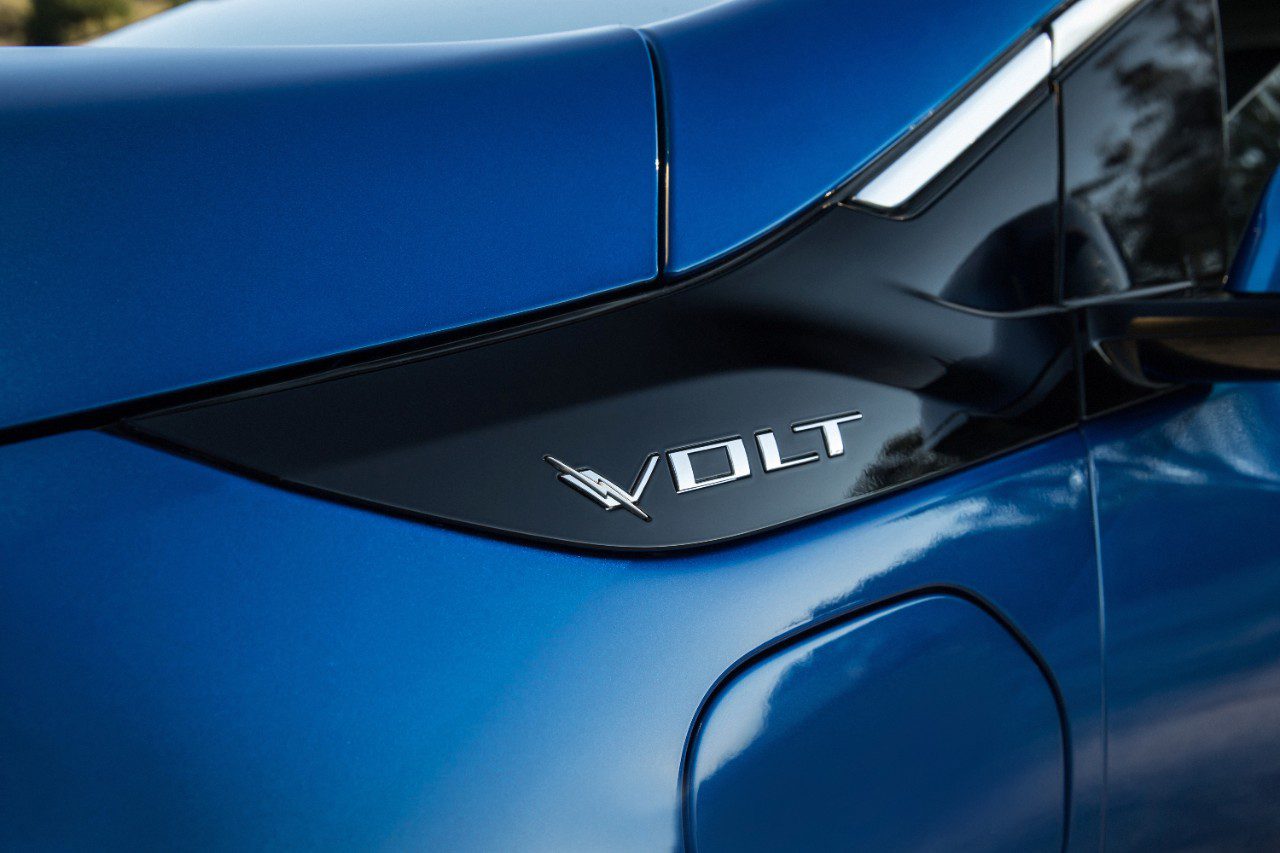
Contents
Introduction
Roll the clock back to 2011, and you’ll find only a handful of electric vehicles (EVs) on the market. The sales leader at the time was the original Nissan Leaf, boasting about 85 miles of range. And the sole Tesla model available was the two-seat, Lotus-based Roadster with a price tag of over $100,000. EV sales for the year totaled just 17,000 units.
Enter the Chevrolet Volt. The Detroit-designed and -built compact sedan offered sharp looks, room for four, and an innovative hybrid-electric powertrain that could travel well over 300 miles without a refill. GM reportedly spent a billion dollars developing the car. Yet you could buy it for just $32,495 (after federal incentives).
No wonder the Volt was a hit, racking up an impressive list of kudos, including North American Car of the Year and World Green Car, and landing on Car and Driver’s 10Best list, the first electrically powered car to do so. It quickly became America’s best-selling EV, a crown it held for many years, only recently ceding it to the Tesla Model 3.
The qualities that made the Volt a popular new car — its outstanding fuel efficiency, robust engineering, and affordable price — make it an even better used one. After nearly a decade of production spanning two generations, plenty of Volts are available for sale on the used market. And thanks to deprecation, excellent used examples are now available for as little as $10,000.
But which is the best Chevy Volt to buy? And are there any problem areas to avoid? We explore that and more in this detailed buyer’s guide.
EV or Hybrid?
- Designed as a plug-in hybrid but propelled primarily by electric power
While the Chevrolet Volt may seem rather mainstream these days, it was one of the most revolutionary cars on the road when it debuted. GM was still feeling the sting from the flop of its first electric vehicle, the too-early-for-its-time EV1 (1997-99), and they engineered the Volt to ensure its success wouldn’t be hampered by a lack of range or utility.
Unlike the EV1, which only had room for two and could (initially) travel just 55 miles per charge, the Volt seats four and boasts over 300 miles of range. How? Instead of making it a pure battery-electric vehicle like the EV1, GM designed the Volt as a plug-in hybrid (PHEV) — and a unique one at that.
Where most PHEVs (such as the Toyota Prius Prime) use electric power to supplement an internal combustion engine, the Volt does the opposite. It runs primarily on electric current, drawn either from its battery pack or its onboard four-cylinder engine. While the engine can drive the wheels directly, it does so only under specific circumstances, such as at higher speeds with a low charge level.
In other words, the Volt uses electricity as its primary power source, with a gasoline engine to generate additional juice as needed. Accordingly, GM calls it an “extended-range electric vehicle.” Whatever you call it, it works remarkably well.
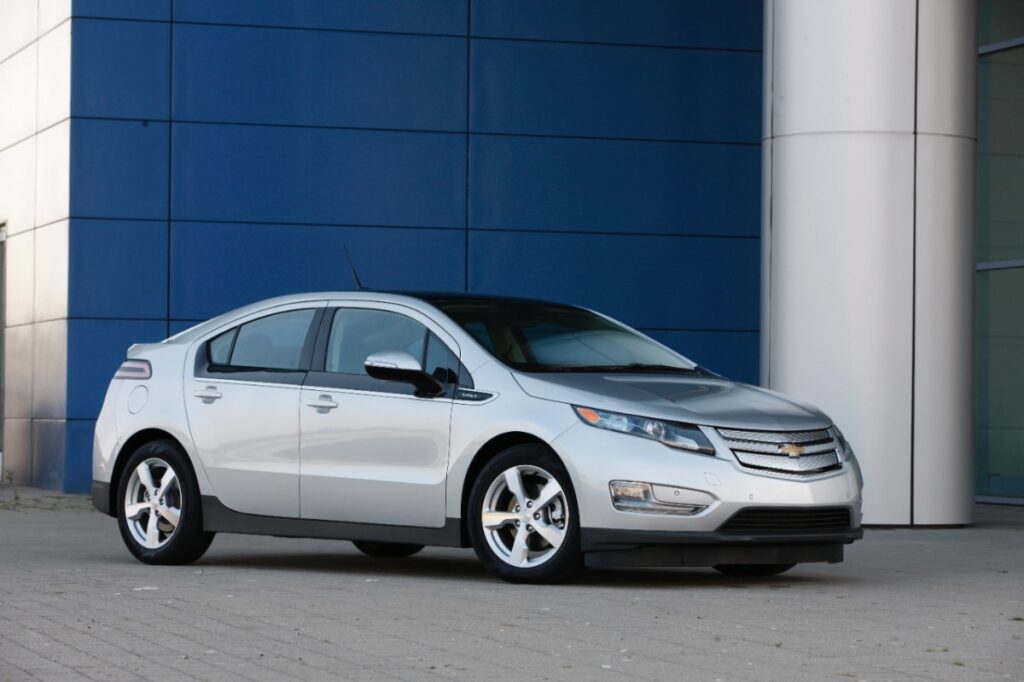
First Generation (2011-2015)
- Lauded for its unique styling and groundbreaking engineering
When the first Chevrolet Volts started rolling into showrooms, GM was just emerging from its 2009 bankruptcy. The automaker had invested a significant chunk of its scarce resources into the new model’s development and production, so the stakes were high. Very high. That’s because, as noted above, the Volt wasn’t just a new car. It was an entirely new approach to automotive propulsion. Amazingly, the launch came off with nary a hitch.
Reviewers of the day praised the Volt for its distinctive styling, innovative engineering, and excellent road manners. In its full test at the time, Car and Driver concluded, “This is without a doubt the most important new car since the advent of hybrids in the late ’90s, and GM has nailed it.”
Performance and Range
- About 35 miles of electric-only range, plus 344 more miles with its 1.4-liter engine
- Recharging via a standard 120V outlet takes about 12 hours
Much of the Volt’s success is due to its unique hybrid-electric powertrain, which offered far more range than any competing model at the time. Its 16-kWh battery pack supplies enough current to provide 35 miles of electric-only driving — plenty for most errands and commutes. But the game changer is its supplemental 1.4-liter four-cylinder engine, which generates enough additional electrons to travel 344 more miles on a single tank of gas. That means the Volt is more than just a city car. It’s a long-haul cruiser, as well.
Performance isn’t too shabby, either. With a 149-horsepower electric motor driving the front wheels, the first-gen Volt can scoot to 60 miles per hour in about nine seconds. More importantly, it offers a healthy 273 pound-feet of instantly available torque, allowing drivers to summon a pleasant shove of acceleration whenever needed or desired.
The Volt is also designed for easy charging. It comes with its own charging cord, which fits into a standard household socket. A 120V outlet can refill the battery pack in about 12 hours, while a 240V outlet cuts that figure by a third. To ensure a long and healthy life, the Volt’s liquid-cooled battery pack is engineered to operate between 30-80% of capacity. It’s also warranted for eight years or 100,000 miles.
GM increased the first-gen Volt’s battery capacity to 16.5 kWh for the 2013 model year, improving its battery-only range by 3 miles to 38 total, according to EPA estimates. Another slight battery upgrade came in the first-gen’s final production year (2015); however, GM didn’t certify the change, so its official range rating remains 38 miles.
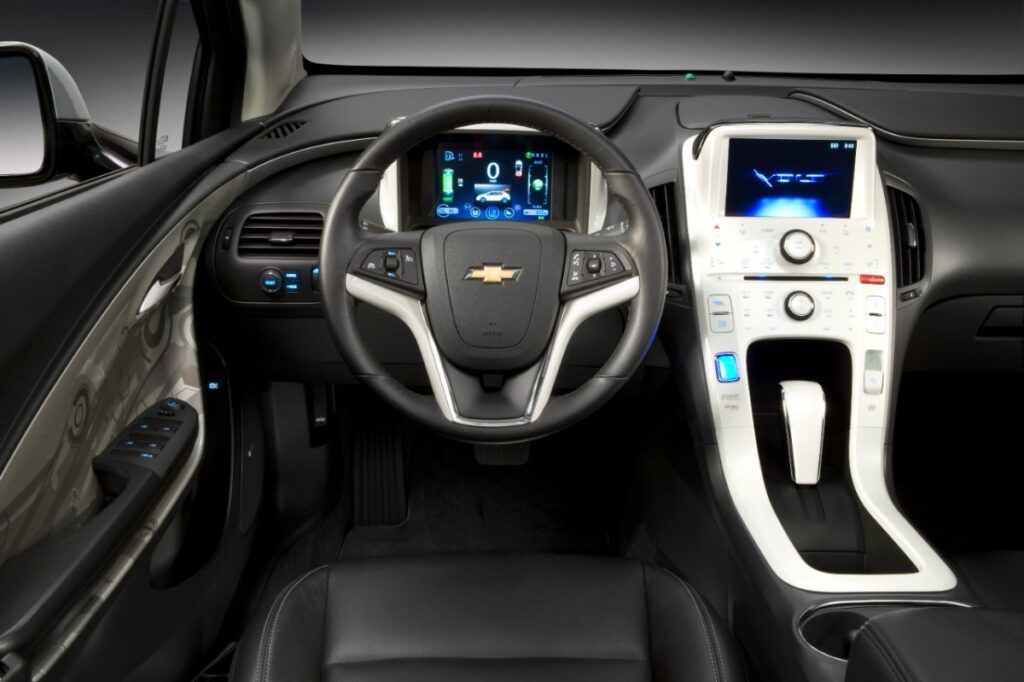
Features and Options
- Seven-inch infotainment touchscreen and digital gauge cluster
- Some advanced safety tech added in 2013
The Volt also feels special on the inside, especially considering it shares its basic platform with the far more pedestrian Chevy Cruze. The Volt’s premium, tech-oriented cabin centers around a distinctive center stack, which seems to have been inspired by the original Apple Macintosh computer. It houses a seven-inch color touchscreen along with an array of touch sensors and knobs to control the audio, HVAC, and other systems.
In place of traditional gauges, the Volt gets a futuristic digital cluster. The seven-inch customizable screen provides the driver with the basics (speed, fuel, range) as well as a video-game-like floating green ball, which helps to visualize the effects of acceleration and braking on overall efficiency. Hint: smoother is better.
A T-shaped battery pack takes up the space where the middle seat in the back would be, making the Volt a four-seater. Still, the compact EV feels relatively spacious inside, though taller passengers may find the rear seats a bit cramped. “Overall interior quality is also high, with materials that seem to be the best yet from recently improved Chevrolet,” noted the Edmunds review.
Continuing the premium theme, Volts came well-equipped from the factory. At launch, its standard equipment list even included navigation and a premium Bose audio system with Bluetooth connectivity. Those features became optional in subsequent years, however.
Also optional (starting in 2013) was some rather advanced (for the time) active safety tech, including a forward collision mitigation system and lane departure warnings. To protect occupants in a crash, the first-gen Volt employs eight standard airbags and a structure of nearly 80% high-strength steel.
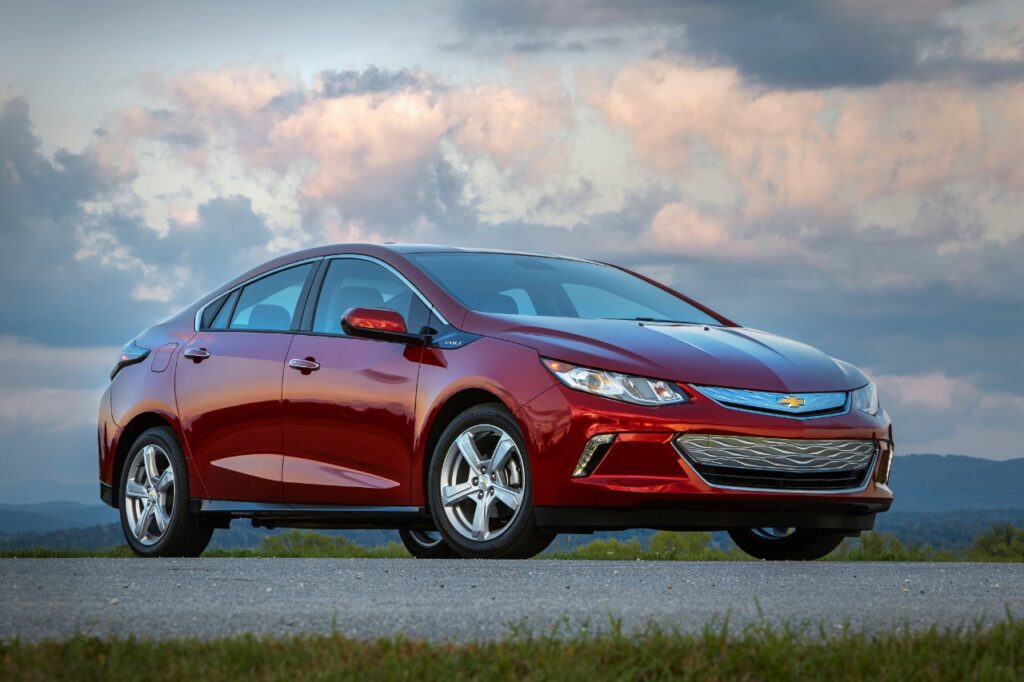
Second Generation (2016-2019)
- More conventional design addresses concerns raised about the original car
Chevy took the Volt more mainstream with the second generation, which debuted at the 2015 North American International Auto Show (for the 2016 model year). Gone were some of the first-gen Volt’s more distinctive design elements, such as its slab-sided exterior and bold (but already dated-looking) center stack. In their place, the second-gen car got more conventional but still attractive styling inside and out. While less polarizing, the new look is also more anonymous, making it hard to distinguish the sophisticated PHEV from its cheaper gasoline-powered sibling, the Chevy Cruze.
On the plus side, the Volt product team reportedly spent many hours pouring through feedback from first-gen owners and used their likes and dislikes as a guide for building the new one. That means the revised Volt addresses many of the issues that owners had with the original.
Performance and Range
- All-electric range increases to 53 miles thanks to a larger battery pack
- More efficient and quieter range-extending engine
- Recharging time increases to about 13 hours using a 120V outlet (due to the larger battery)
While the looks of the updated Volt may be a letdown, its revamped powertrain is not. Chevy made several notable improvements that substantially elevate the newer Volt’s behind-the-wheel experience over the outgoing car.
First and perhaps most important, the second-gen Volt boasts about 40% more all-electric range. Where the original was rated at 38 miles per charge, the newer version adds 15 more for a total of 53 gasoline-free miles. Chevy accomplished this primarily by fitting a lighter but more powerful 18.4-kWh battery pack (up from 16.5 previously). They also upgraded its electric propulsion system from one to two motors, which helps to deliver more efficient and quieter performance.
And that’s not all. Under the hood, Chevy fitted the second-gen Volt with a slightly larger and thriftier range-extending engine. The new 1.5-liter all-aluminum four-cylinder is lighter and more powerful than the outgoing iron-block mill and makes its power lower in the rev range. Behind the wheel, that translates to more seamless and responsive operation. And unlike the prior unit, the new engine burns cheaper regular gas, reducing running costs.
These changes knock the second-gen Volt’s 0-60 time down to 8.4 seconds, and they also boost its total range to an impressive 420 miles (with fully charged batteries and a full gas tank). That’s what we call a win-win.
Charging times are slightly longer for the second-gen Volt since its battery pack has more capacity to fill. Estimates are 13 hours using a 120V outlet and 4.5 hours with a 240V outlet. However, for the Volt’s final year (2019), Chevy introduced an optional fast-charging system, which reduces those times by about half.

Features and Options
- Larger interior with room for five
- Innovative steering-wheel paddles for adjustable regenerative braking
- More available tech features, including smartphone integration and adaptive cruise control
Inside the second-gen Volt, things are quite different. The cabin no longer looks like a 1990s sci-fi set piece. Instead, it’s a thoroughly modern design, with a large touchscreen dominating the center stack and traditional buttons and knobs replacing the original car’s sometimes finicky touch sensors. The digital instrument cluster remains, but it’s updated with more straightforward and easier-to-read graphics, which is a nice improvement over the rather congested appearance of the original.
New paddles on the steering wheel allow the driver to ratchet its regenerative braking levels up and down. This innovative feature has since been copied by many other EV automakers (including Honda and Mercedes-Benz), and it makes the Volt capable of one-pedal driving.
Rear seat occupants benefit from a slight stretch of the wheelbase, which provides much-needed additional legroom. The new rear bench also sports a viable seat in the center, making the second-gen Volt a five-seater. But it’s still not exactly roomy back there.
Other notable features on the second-gen Volt include: Apple CarPlay and Android Auto integration (the latter coming halfway through the 2016 model year), a standard rearview camera, and a suite of available active safety tech, including lane-keeping assist, blind-spot warning, rear cross-traffic alert, forward collision warning with automated braking, and front and rear parking assist. Adaptive cruise control also became an option starting with the 2017 model year.
Reliability
- Above average reliability across all years
According to consumer data powerhouse JD Power, Chevy Volt reliability compares favorably with one of the most reputable models out there, the Toyota Prius.

Looking at the Volt’s Quality & Reliability scores — which, according to JD Power, combine initial quality ratings with dependability results over the prior three years — they only slightly trail the benchmark Prius, most notably in the first few years after the second-gen Volt debuted. However, its scores never veer below what JD Power calls “average.”
That’s impressive, considering that the Volt has the more complex powertrain of the two models. It also speaks volumes about the rigor GM engineers used when developing the original car.
Battery Life
- Excellent battery longevity, with some owners exceeding 400,000 miles
- Liquid-cooling aids in durability vs. air-cooled competitors
If you’re considering a used electric car such as the Volt, you’re probably concerned about battery life. And rightly so. Replacing a failing EV battery pack can cost $10,000 or more. The good news is that Volt owners generally report excellent battery longevity. In fact, according to a story on InsideEVs, one Volt owner even racked up over 400,000 miles on his car’s original powertrain with only negligible battery degradation.
The Volt’s battery pack’s durability is undoubtedly aided by the fact that it’s liquid-cooled. That’s a benefit the Volt enjoys over many other budget-friendly EVs, including the Nissan Leaf, VW e-Golf, and Fiat 500e, which are all air-cooled. Liquid cooling adds cost, so it’s typically reserved for more expensive EVs (e.g., the BMW i3 and all Tesla models). Still, it ensures that exposure to heat doesn’t degrade the batteries’ performance or capacity over time.
Chevrolet also warranties the Volt’s battery pack for eight years or 100,000 miles from its original in-service date, meaning that most 2015 and later models are still covered by their original factory warranty.
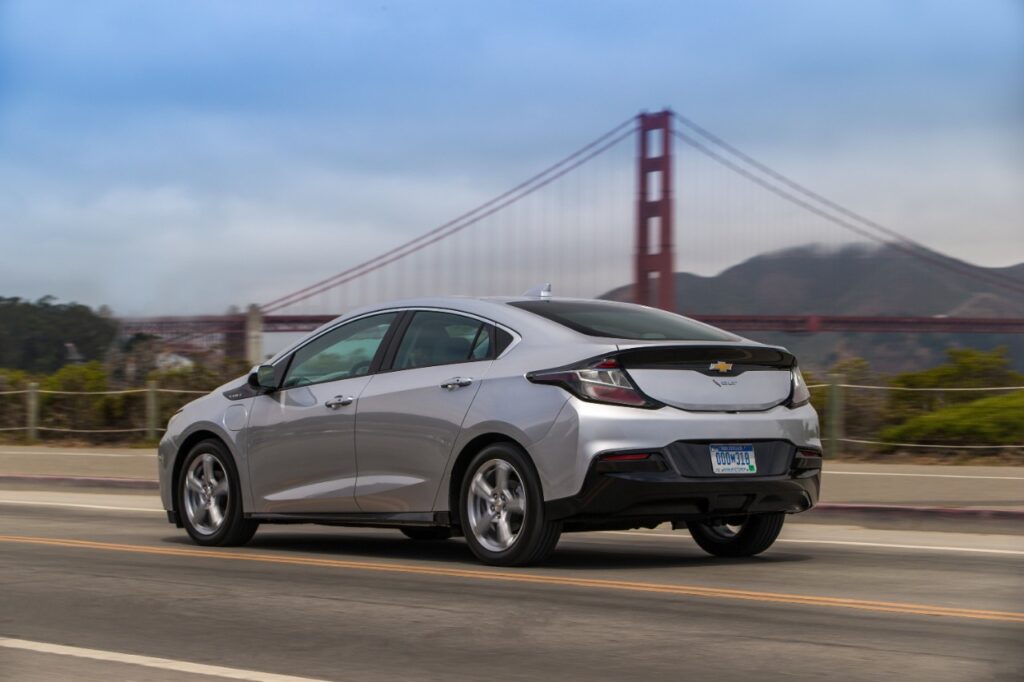
What are the Best Years?
- For a budget-friendly choice, aim for a 2013 or later first-gen Volt for its upgraded battery
- Consider a second-gen Volt (2016-2019) for its significant powertrain improvements and modern tech
In a recent search on Autotrader, we found nearly 600 used Volt examples for sale nationwide. They ranged in price from a low of about $7500 for the earliest model years with well over 100,000 miles on the clock to almost $30,000 for final-year examples with under 15,000 miles.
If you have $12,000 to $15,000 to spend, you can find a well-kept first-gen Volt (2011-2015) with under 60,000 miles. We’d steer you towards a 2013 or later model since they feature an upgraded battery pack with more all-electric range. If you live in a colder climate, look for examples with the optional heated front seats. Earlier Volts are somewhat notorious for weak heater performance, making seat warmers practically a must.
Up the budget by $ 3,000 to $ 5,000, and suddenly excellent second-gen Volts (2016-2019) are in play. We found numerous sub-60,000-mile examples from the first few model years offered for under twenty grand. Considering Chevy’s powertrain improvements to the second-gen car, it’s well worth the additional coin. The newer cars also come with modern conveniences such as a backup camera and Apple CarPlay integration, not to mention more active safety tech.
That said, if you’re a fan of the first-gen styling, you could also spend similar money on a minty 2015 example, which is the final year of the original design. It boasts the most up-to-date battery tech and may still be covered by its original factory powertrain warranty (8 years/100k miles).
Spending more than $20,000 on a used Volt gets you into one of the newest model years with unusually low miles (under 30k) and also likely some of the more upscale options, such as leather seats, automated parking, and a full suite of active safety equipment. The latter could include adaptive cruise control (ACC) for 2017 and later models.

Pro tip: You can spot a Volt with ACC by looking at the grille. If the Chevy bowtie badge looks like it’s painted flat on the surface (as seen above), that means the car has ACC. However, if it’s glued on like a traditional badge, the vehicle does not.
Finally, before you spend thousands on a used Volt, we highly recommend hiring a Chevrolet specialist to evaluate it. For about $250, they’ll provide you with a thorough inspection of the entire car. This can reveal potentially deal-breaking issues, such as hidden accident damage, excessive battery wear, or minor things you can use as bargaining points, like worn brake pads or aging tires. Either way, completing a professional inspection before finalizing any used car purchase is easily worth the money.
Photos courtesy of Chevrolet